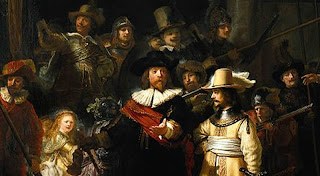.jpg) |
| New Netherlands, titled New Belgi, original map 1665 Wikipedia |
During this time the Dutch colony of New Netherlands came and went. The earliest Dutch settlement was in 1613. Recognizing a lucrative fur trade with the Indians, the Dutch chartered the Dutch West Indies Company to establish colonies and bring over settlers.
In 1617 the Dutch established Fort Orange at the confluence of the Hudson and Mohawk rivers where the city of Albany is now found. By 1629, Kiliaen van Rensselaer, a charter member of the Dutch West Indies Company, established Rensselaerswyck, surrounding Fort Orange. Van Rensselaer chartered several ships to bring in settlers for the new colony. This likely included the ship Den Harinck, which arrived in July of 1639 carrying Jan and Volkje.
 |
| detail, Rembrandt's The Night Watch, 1642 |
The colony prospered. During the 1640s, Beverwijck, (beaver village) a settlement of fur traders north of the fort, was established. Beaver pelts were bought from the Mohawk Indians and shipped back to Holland where they were made into hats worn by the rich. (See the gentleman in the center of Rembrandt's painting The Night Watch). As I noted, Jan and Volkje prospered. Jan bought for the price of 500 guilders, about 70 beaver, his own land in June of 1662 from the Indians, calling it Claverack, (field of clovers). Van Rensselaer, who was not a man to be trifled with, sued Jan over the question of title.
Call it a stroke of luck or the fortunes of history.
In 1664 King Charles II of England turned his eye to the Dutch colony in America. James, Duke of York and brother to King Charles II, chartered four English frigates. They sailed into the port of New Amsterdam and achieved a surrender of the Dutch colonies without firing a shot. The Dutch colonies officially became English three years later with the Treaty of Breda.
This was fortunate for the Van Husum claim, for the new English courts sided with Jan and his heirs. And the first English colonial Governor Richard Nicolls granted the land patent at the colonial capital of Albany on May 14, 1667.
Notes.
1. Jan and Volkje were a part of a large group of emigrants from Schleswig. This emigration took place after the terrible flood of 1634 and was also a result of the religious wars that shook northern Europe. Schleswig-Holstein Immigrants in New Amsterdam/New York,1636 - 1667.
Jan is identified "Hans Fransen", number 24 on the list of immigrants.
2. Beaver pelts trading took place from May to November, a time called the Handelstijd (trading time). The Mowhawk Indians would bring their pelts to town and the townspeople would all engage in "earning a pelt". At its height, the Handelstijd took in 50,000 beaver pelts. these pelts were then shipped to European markets. See Rituals of the Handelstijd at Beverwijck, by Donna Merwick. Beaver pelts fluctuated in price between 6 and 8 guilders a pelt. See Money Substitutes.
3. For more information about early Dutch history, read A Tour of New Netherlands.

No comments:
Post a Comment